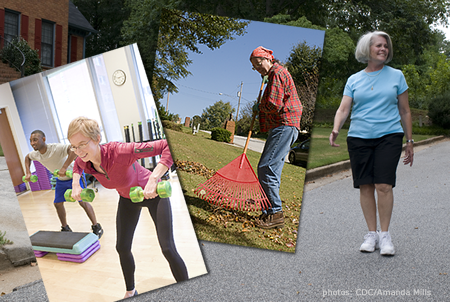Exercise for Caregiver Health and Well-being

Family Caregiver Alliance Sally provides regular care for her who suffers from Multiple Sclerosis. Between doctor’s visits, helping with personal hygiene, and worrying about growing problems with walking, Sally has found herself suffering from an increased number of headaches and extra weight. Before her partners health decline, Sally attended weekly exercise classes and ate a more balanced healthy diet. However, now that she heads straight home after work, there’s not much time for the gym and she’s noticing the negative effect of more sitting and the late night eating in front of the TV. Most caregivers know all too well the effect of stress associated with caring for a loved one. Family Caregiver Alliance’s Selected Caregiver Statistics fact sheet notes that 25% of male caregivers and 35% of female caregivers report high stress due to caregiving. From headaches, to increased blood pressure and weight gain, stress can have a significant impact on the well-being of caregivers. When caregivers feel better about themselves there is a greater inner reserve to draw upon to support caring for someone else. Exercise Provides an Outlet Unfortunately, there’s no magic cure for the demands of caregiving, but many caregivers may find some relief and relaxation via exercise. While pumping iron at the gym may sound unrealistic (or unappealing) to caregivers already short on time and energy, research has shown that caregivers can find health benefits and stress relief in everything from yoga to marathons. For caregivers struggling to find simple ways to fit activity into their daily routine, here are a few suggestions that can make an impact on your overall well-being without overwhelming your list with one more thing to do: Yoga/Meditation Stretching and strengthening your muscles while calming your breath is good for everyone, and especially good for those providing care to another person. A recent study of Alzheimer’s caregivers by UCLA found that meditative yoga practiced regularly for 8 weeks had showed improvement of depressive symptoms in 65% of study participants. Yoga and meditation instruction online make it easier now more than ever to take a virtual class from home. Walking Walking is another wonderful physical activity that doesn’t require any equipment or extreme exertion, but can have significant health impacts. A regular routine of brisk walking, which can start at as little as 10 to 15 minutes a few times per week and slowly increase to 30 to 60 minutes at a time, can help lower blood pressure, raise good cholesterol, reduce body fat and give your mind a chance to relax. (The Mayo Clinic provides a short article on the numerous health benefits of walking.) Gardening and Household Chores All those household chores to get done, like vacuuming, ironing, cleaning the bathroom , or mowing the lawn …Can they be turned into beneficial physical activity? The stretching, lifting and increased physical exertion associated with chores that require you to get up and move around can benefit your health and mood. A listing by the National Heart, Blood and Lung Institute shows how much time doing each chore will gain positive benefits. http://www.nhlbi.nih.gov/health/public/heart/obesity/lose_wt/phy_act.htm. Go ahead, burn a few calories making those chores a little less onerous! Weekly Exercise Classes Some caregivers find stress relief in knowing that they have a regular break to look forward to. Regular exercise classes, which may include everything from a dance class at the gym to water aerobics at the community center, are a source of stability in a routine and an escape from the everyday rigors of caregiving. If this is an option you’d like to explore, but worry about a lack of time, consider hiring a home care agency to provide respite care for a couple hours each week, or coordinate with a family member or friend to fill-in while you take some time for yourself. Caregiving is not always easy. Feeling stressed out, over-worked and even a little sad is normal. You may find that taking time for your well-being by practicing yoga, taking a trip to the gym, strolling down the street or even mowing the lawn, can have a noticeable impact on how you feel, both mentally and physically. For more information on making time for yourself, see our fact sheet “Taking Care of YOU: Self-Care for Family Caregivers.” Content contributed by ClearCare, Inc.
